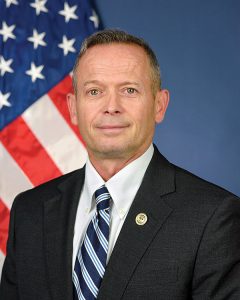DCA’s Balzano Discusses Dredging Outlook, Challenges
Richard Balzano is the CEO and executive director of the Dredging Contractors of America. He has served the maritime trades in both the private and government sectors for more than 30 years.

Balzano is a combat veteran of both Iraq and Afghanistan, retiring from the U.S. Navy at the rank of captain. In the private sector, Balzano held leading positions in the defense, commercial maritime and nuclear utility industries. In the public sector, he served as senior staff on the U.S. House of Representatives Committee on Homeland Security and spent three years as the presidentially appointed deputy administrator for the U.S. Maritime Administration.
The Dredging Contractors of America, a non-profit trade association, has represented the interests of the U.S. dredging and marine construction industry and its members for more than 30 years.
Waterways Journal: What do you know about the Corps’ dredging plans, and when will they be announced? Have members of your industry had any input into them or interactions with the Corps?
Balzano: We know the Corps is working on them, and we understand that they have a process to follow. We are working with Corps headquarters to set up a long-term scheduling and planning meeting.
WJ: Is dredging money from last year’s WRDA still coming through?
RB: We are very pleased with WRDA on a two-year cycle and the appropriations that have followed. The Corps is still working to get projects out for bid as far as we know. We as an industry have met with them and are standing at the ready to help them execute on their contracts.
WJ: What is the state of private dredging projects? Are customers like municipalities and marinas pulling back on dredging because of COVID?
RB: For the most part the work still needs to be done. We are still seeing progress with the non-Corps projects, but like everything else, COVID adds that much more time and planning to each project.
WJ: Will there be consolidation in the dredging business this year?
RB: Actually, the U.S. dredging industry is expanding, not consolidating, and getting more competitive. This is a direct result of the robust funding that Congress has provided the Corps for navigation and coastal protection projects that is resulting in a tremendous boom in building new dredges of all types.
WJ: Apart from the infrastructure money specifically directed toward inland waterways or port projects, is there any other infrastructure money coming that will require dredging—such as for bridges or similar projects?
RB: Yes; as is the case with many marine construction projects, we expect some [other projects] to include the need for dredging—incidental and otherwise.
WJ: How has the price of steel affected the dredging industry? Is it a big concern?
RB: Steel prices and [the prices of] other commodities are affecting all industries, including the maritime industry and the dredging components of it. The high cost of steel is having a significant impact on new-build costs and major repairs.
WJ: Are offshore wind projects having a big impact on the dredging industry?
RB: Offshore wind is a growing and emerging marketplace; dredging will most certainly be a component of that marketplace. Additionally, many of our member companies already provide services in the offshore and marine construction space; each has their own corporate strategy on how they plan to participate in the bourgeoning wind market.
WJ: What are the most encouraging developments in beneficial use of dredged material?
RB: The Corps’ Regional Sediment Management program goes hand-in-hand with beneficial use, and the Corps has set ambitious beneficial use goals. The fact that it is getting some attention is great for the industry, great for the Corps and great for state and local communities … and most importantly great for the taxpayer. Beneficial use is a win-win-win; it reuses material, it can rebuild beaches and coastal communities, and it reduces the industry’s carbon footprint by saving steaming time to dump sites. It just makes good sense and is good environmental stewardship!
WJ: What is your top prediction and/or concern for the coming year?
RB: My top prediction is ongoing progress in our industry partnering with the Corps on issues related to employee safety and the measurable advances we expect to jointly make in this area.
The Corps’ ability to execute their mission with additional project funds but without additional staff, along with the continuing COVID issues we all face, are concerns. From my previous position in the federal government, I have personally experienced having Congress give my agency additional funds [and tasks], but no additional staff to administer [them], and it’s not easy. So I understand the Corps’ challenges ahead.
One thing I found to be successful in my previous federal positions was to consolidate contracts, regionalize them, etc., and the Corps has already taken useful steps in that direction.



